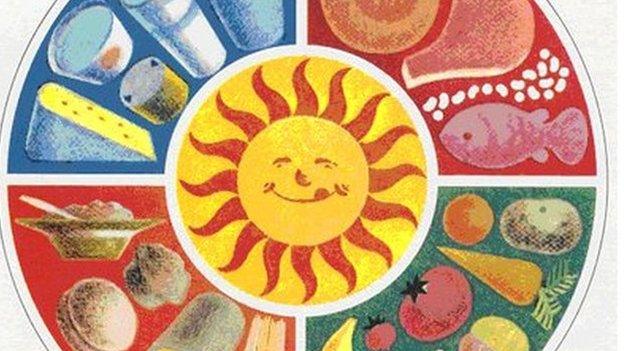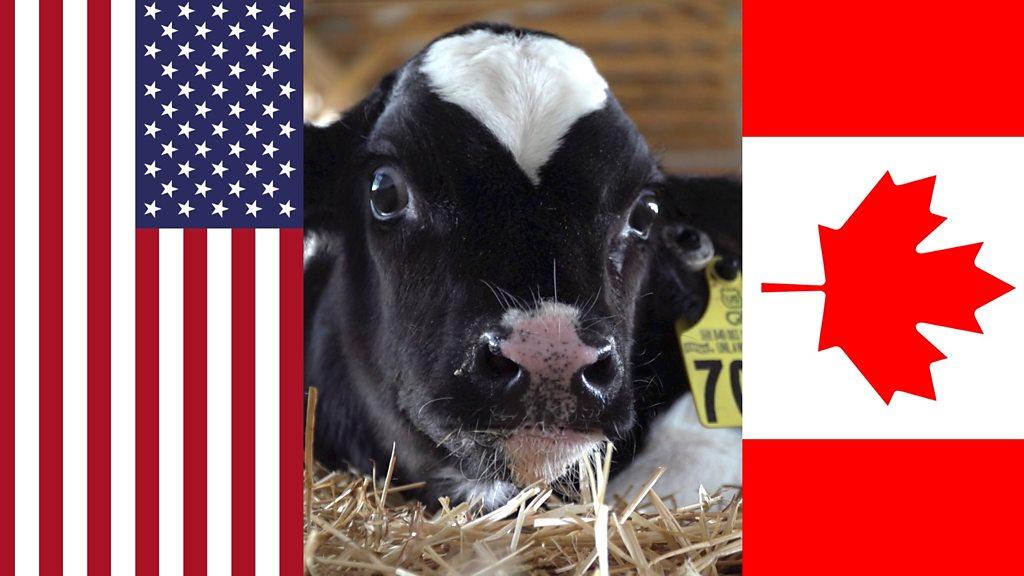Is milk healthy? Canada's new food guide says not necessarily
- Published

Healthy eating advice has changed over the years, as foods have become more processed
Canada has released a new food guide, and one thing is noticeably missing - a daily dose of dairy.
The guide does away with food groups entirely, and instead encourages people to eat a variety of unprocessed foods.
The last time the food guide was updated was in 2007, and the version unveiled on Tuesday took three years of consultations.
The changes have been praised by advocates for plant-based diets, but have raised the ire of the dairy lobby.
Canada's food guide provides Canadians with nutritional advice for optimal health.
The latest edition does away with many standard elements, like food groups, serving sizes and the recommendation that 100% fruit juice can substitute whole fruits.

Canada's food guide uses a plate to represent healthy portion sizes
For years, people had criticised the guide for kowtowing to the meat and dairy industries.
The latest guide course-corrects, says Dr Hasan Hutchinson, director general of Health Canada's office of nutrition policy and promotion.
"We were very clear that when we were looking at the evidence base that we were not going to be using reports that have been funded by industry as well," he told reporters the day before the guide was made public.
No more three-a-day
Dairy has long had a central role in health policies in Canada and other Western cultures.
Since the food guide was first published in 1942, Canadians have been encouraged to eat or drink several servings a day.
But no more.
Instead of recommending Canadians get a specific number of servings, the guide lumps dairy in with other proteins.
Canadians are advised to fill half their plate with fruits and vegetables, a quarter with starches or grains and a quarter with protein.
The plate analogy is supposed to be more intuitive than a specific list of foods and serving sizes.
The US did something similar in 2011, when it switched from the "food pyramid" diagram to "MyPlate".
In the US, the plate is divided into four sections, but unlike Canada's food guide, it includes an image of a glass of milk.

USDA's MyPlate replaced the iconic food pyramid in 2011
The new food guide also calls out chocolate milk, in addition to juice, as a culprit in the growing childhood obesity crisis.
For decades, parents have been giving their children flavoured milks as a way to entice them to consume dairy.
But the new guide says the sugar outweighs the nutritional benefits. Recent research shows the majority of a child's sugar intake comes from sweetened beverages.
Creameries sour
The move away from meat and dairy requirements has won praise from vegetarian and vegan advocates, including Dr David Jenkins, the Canada research chair in nutrition and metabolism and a professor at the University of Toronto.
Dr Jenkins created the Glycaemic Index in the 1980s, and now follows a plant-based diet for environmental reasons.
"I think [the guide] is moving in a plant-based direction, which will ruffle some feathers, but I think that's the direction it needs to go," he said of the new food guide.
He says we have erroneously placed "cow's milk next to mother's milk" in terms of its importance for human health.
The dairy industry is - not surprisingly - less than thrilled about these changes.
Earlier this month, the Dairy Farmers of Canada released a statement warning that the new guide could hurt Canadian farmers, especially after recent trade concessions made to the US during the negotiations of United States-Mexico-Canada Agreement.
Dairy wars: Why is Trump threatening Canada over milk?
"There is no scientific justification to minimise the role of milk products in a healthy diet," it wrote, citing numerous studies promoting milk's health benefits.
The guide comes at a time many Canadians are cutting back on meat and dairy, for environment, health or ethical reasons.
Milk consumption has declined since 2009, according to Statistics Canada, while the popularity of plant-based milk-alternatives have grown.
In that way, the new food guide is not so much predicting the future, but catching up to it.
"It's not particularly new to say eat more fruits and veggies, people have been saying this for a while," Dr Jenkins says.
"This is not radical stuff."
- Published28 December 2016

- Published26 April 2017

- Published14 January 2019
